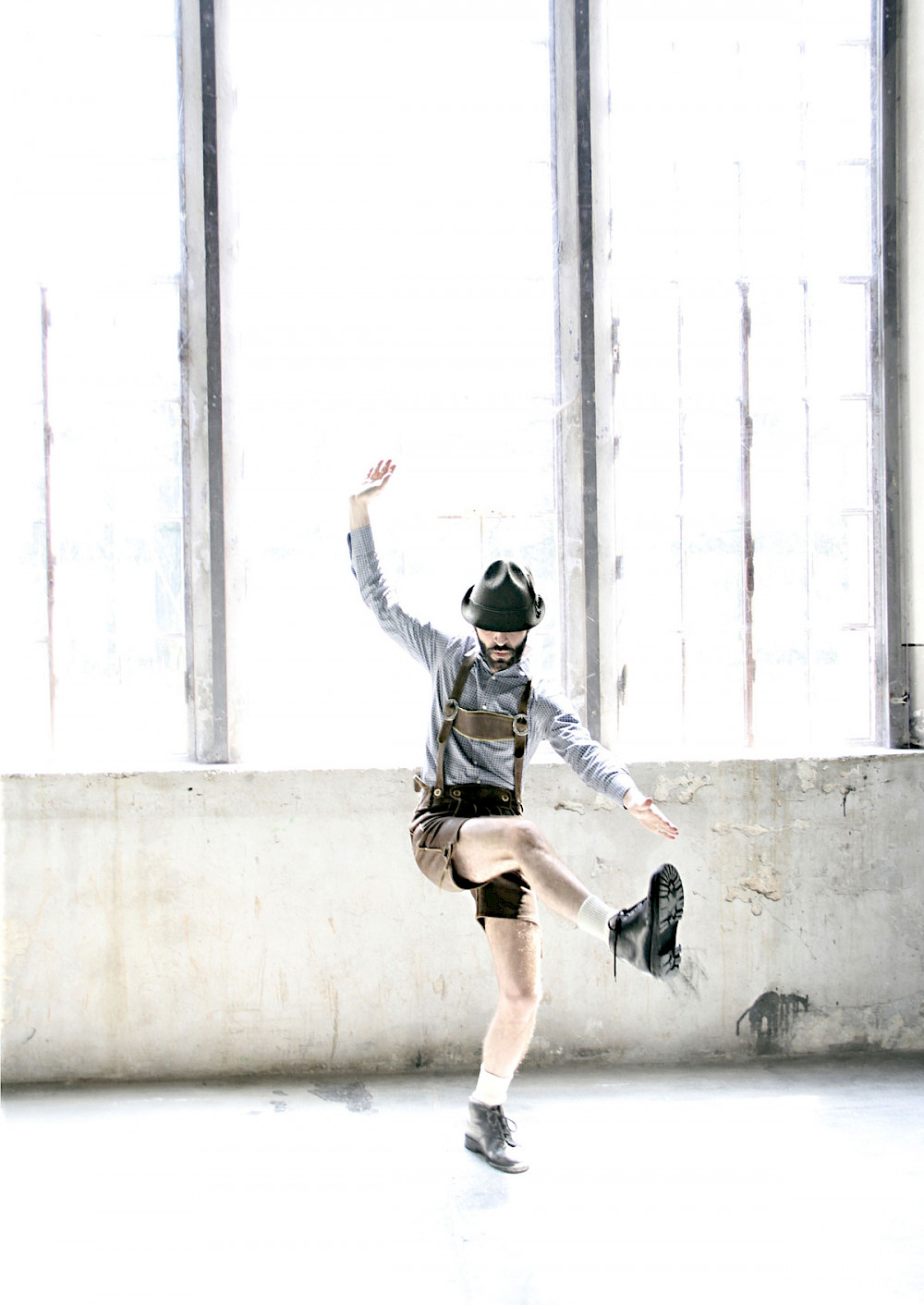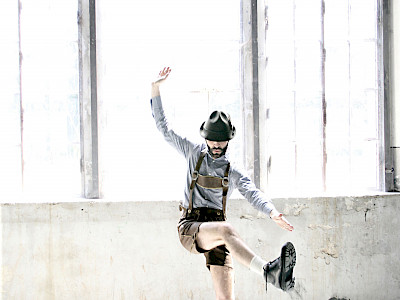16 — 19.05.2014
Folk-s takes as its starting point the Schuhplattler, a traditional dance from Bavaria and the Tyrol in which one strikes the legs and the soles of the shoes with one’s hands. Six dancers repeat the same movements over and over again. They burst with energy and are stimulated by the rhythms of the percussion. Each and every time they search for one another, coordinate their movements, detach, and start searching again. The variations in their movements pile up, the music goes off and on. A timeless ritual becomes visible, an endlessly repeating loop in a perpetual present. It becomes a war of attrition for the dancers and the audience: the show continues until the last spectator leaves the room. The young Italian choreographer Alessandro Sciarroni – at the festival for the first time – turns the folkloric dance into a conductor of human identities and connections. He yanks the dance out of its traditional context and imposes it as a rule, a dictation, a struggle for survival. Eventually we are left with a simple choice: do we follow the group, break off, or go our own way?
Folk-s
Everything starts with an image. There are images with the extraordinary power to spring spontaneously from creative sparks. And there are artists who abandon themselves totally to these sparks, so that the concept conveyed by the chosen medium might indeed duly reveal itself, above all, giving way to a visual and emotional vertigo, to a representation whose margins potentially enclose the traces of all the arguments that may be present. These arguments will emerge bringing with them powerful, urgent and purely instinctive needs and actions, exhibiting a minutely-calculated diaphanous shape, through which can be perceived the complete outline of its creative skeleton.
This is the process Alessandro Sciarroni presents to the gaze of his audience and at the same time, with precise “rules of the game” that the audience itself can use as a detonator, the complete, fully dynamic shape is created in a fresh communion between stage and stalls. Folk-s Will you still love me tomorrow?, first step in a trilogy that will be completed in the next season, is above all an arabesque on the concept of tradition, a scenic composition that favours the “time-image” over the “movement-image”, in the words of Gilles Deleuze, a visual body that creates, destroys and recrystallizes cells of various dimensions and durations, until it builds a drama of time from nothingness.
The still or moving image is always the starting point for Sciarroni’s work; he used to be an actor, loves performance art and draws inspiration from photography and literature. In the case of Folk-s, he took a shot by Sam Taylor-Wood portraying the American singer-songwriter Rufus Wainwright, framed in the sacred whiteness of a bourgeois interior, wearing traditional Tyrolean costume. Short breeches, thick, woollen knee socks and a comfortable, relaxed pose, detached and earnest, centred in his potential estrangement. “I felt that this image could have a powerful impact on the present day”, the Italian artist then explained, for which one of the keys, capable of opening wide the spectator’s perception, yet without relying on prefabricated categories, is the courage to place sensible elements in contexts where they do not belong, shattering expectations and preconceived shapes within a radical redefinition of codes. This happens because the reaction of this artist to images and suggestions is a kind of surrender, a removal plot that evades a completely rational elaboration, and instead happens as a gradual response to a request, to an obsession.
In Folk-s, a group of six performers gathered in a circle undertake an absolutely philological performance of a pattern (and its variations) of the Schuhplattler Tanz, an exhausting Tyrolean traditional dance based on striking the body and the shoes with the hands. The dance produces rhythmic, rigorous and aggressive sounds, welcoming the audience as they take their seats, as well as emphasising by its ingenuous performance the age of the tradition and its faraway origins. Going well beyond minimal spectacle and durational performance, Sciarroni invents a third way: not a “challenge to the spectator, nor a simple study on how to wear out the body”, but a radical argument around the concept of vision, incarnate in high-level, physical work that, in a symbolic and allegorical way, stages the passing of a tradition and its opportunity to endure longer, and even indefinitely (hence the question Will you still love me tomorrow?) simply through visual suggestion and the complete participation in what becomes here, to all intents and purposes, an experience. Within the boundaries of those arts sitting entirely within the codes, stage and stalls are comfortably in place in their own roles, complicit in a common journey to formal perfection, while still running the risk of attenuating a possible, and perhaps necessary critical vertigo between art and those enjoying it. In this case, the code is instead programmed to explode into a thousand splinters of creativity: “I am setting out to resolve an enigma, asserts Sciarroni, from creation to presentation to the audience, in which I am trying to make this same desire for a solution resonate. And the search continues on the stage, with the spectators.” No argument is therefore tackled in theory, but instead is carried onto the stage just as it is, triggering the explosion of its meaning directly before the gaze of the observer, a kind of “all-seeing narrator” to use the term John W. Graham gave to the first-person narrator of Virginia Woolf’s The Waves, chosen as the element that completes the creative process.
In this kind of “fairy circle”, in which the movement actually never stops, but only follows the circle of variations, drawing the spectator into a game of which the rules are readily explained, the perfection of the patterns and their aesthetic potential successfully symbolise, in translation, the slow and inexorable exhaustion of emotional roots, that would make a carnal experience like a traditional dance (dense with almost tribal symbols in what is for us a non-exotic reality) into a sharp cultural tool, a moment of real sharing. And thus a completely human event.
The narrative process enabled by Folk-s acts directly on the sharing process. The group of dancers respects a strict, but in some way liberating religion of silence, whose dictates do not consist of fixed dogma, but are collected rules of movement used as an open structure, an experimental module in which space and time become permeable dimensions, through the cathartic action of a powerful relationship. In a strict semantic device, the looped repeats of the steps make a purely rhythmic element, and dislocate the joints of time and space, moving towards another, unconventional dimension.
The interaction of the dancers – joined by a single, steady and attentive focus in which muscles and sweat restore the procedure itself from the physical event – is rendered complex and multi-layered by the addition of music played by the performers themselves, signals from an outside world pulsing and evolving meanwhile, together forming reactive agents: at the sound of the footsteps – handled by Pablo Esbert Lilienfeld mixing original pieces and repertoire, but also open to a random selection – the circle opens and closes like a huge animal, breathing deeply and uneasily. And it is in these breaths that the spectator’s participation happens, never carried onto the stage, but involved in a kind of ritual, hypnotic journey, an empathic process not normally known for such strict ways of moving.
Not unlike some forms of explosive narrative, such as those of James Joyce, Alfred Döblin in Berlin Alexanderplatz or in fact Virginia Woolf in The Waves, the opportunity to handle scenic language in such an extreme way leads to a complete redefinition of the whole time dimension, forming an alternative framework, a distortion which is both delicate poetics in its form and yet fractures the form itself, shattering every convention. As in the text of The Waves, in which the English author describes how light moves slowly over the front of the wave, thus introducing a vertical frame, tangential to the monologues of the characters who never really speak to each other, the relationship which in the Schuhplattler dance is created between the performers on the stage and the audience watching, distorted by the repetition of the steps – ensures that time grinds to a halt in passing between the two sides of the paradoxical reef: “non-present” and “non-future”.
And thus the structure abandons every sterile experiment on duration, and showtime invades lived time, asking the audience for a specific and precious quality of attention. Their presence.
Sergio Lo Gatto
Creation & dramaturgy
Alessandro Sciarroni
Folk dancers
Marco D’Agostin, Pablo Esbert Lilienfeld, Francesca Foscarini, Matteo Ramponi, Alessandro Sciarroni, Francesco Vecchi
Original music
Pablo Esbert Lilienfeld
Video & images
Matteo Maffesanti
Lighting
Rocco Giansante
Costumes
Ettore Lombardi
Faith coaching
Rosemary Butcher
Dramaturgical consultant & casting
Antonio Rinaldi
Project curator & promotion
Lisa Gilardino
Choreographic consultant
Tearna Schuichplattla
Presentation
Kunstenfestivaldesarts, Charleroi Danses/La Raffinerie
Production
Teatro Stabile delle Marche, Progetto Archeo.S, System of Archeological Sites of the Adriatic Seas
Co-funded by
IPA Adriatic Cross-Border Cooperation Program
In collaboration with
Corpoceleste_C.C.00#
Supported by
Inteatro, Amat-Civitanova Danza per ‘Civitanova Casa della Danza’, Centrale Fies, ChoreoRoam Europe: Centro per la Scena Contemporanea – Comune di Bassano del Grappa, The Place/London, Dansateliers (Rotterdam), Dance Week Festival (Zagreb), Paso a 2/Certamen Coreográfico de Madrid


